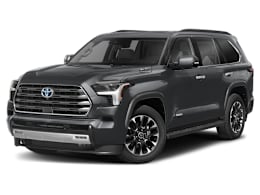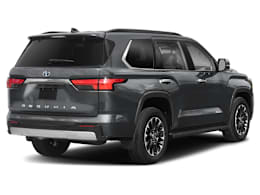The redesigned Sequoia boasts a burly, high-tech hybrid powertrain, but in other ways it feels considerably old-school. Things that made the previous generation unusual or impressive—such as its power-retractable rear window or independent rear suspension—are gone from the new model. Reverting to a live rear axle brings an unsettled ride and, in conjunction with the hybrid battery, greatly compromises cargo space. Clumsy handling, basic interior furnishings, and the lack of an automatic 4WD system make this large three-row SUV feel outdated on arrival compared to its key competitors.
Even with that, the new powertrain is so good (unquestionably the best thing about the Sequoia) that you just might chalk these faults up to old-fashioned charm. The 437-horsepower, twin-turbocharged 3.4-liter V6 hybrid moves the Sequoia quickly down the road with just a mere prod of the accelerator pedal, while the 10-speed automatic transmission performs buttery-smooth upshifts. Zero to 60 mph comes in a class-quick 6.8 seconds and, as a bonus, the 18 mpg overall it managed in our testing is tops within this fuel-thirsty class. Of note, that’s a 3-mpg improvement over the previous V8 version we tested. Maximum towing capacity is over 9,000 pounds—a competitive number.
The less sophisticated solid rear axle—shared with the Tundra pickup truck—results in bumps being announced into the cabin with a shuddering sensation, and occupants get jostled around noticeably. Handling is “trucky,” too; the SUV leans over through corners like a Spanish galleon on the high seas, making it one of the clumsiest vehicles we’ve tested recently. It remained secure and safe when pushed hard around our track, but the Sequoia’s ungainliness equated to a slow 44.5-mph speed through our avoidance maneuver. As with most large SUVs, the Sequoia’s stopping distances are quite long. Wind noise at highway speeds is pronounced, which is unbefitting of a $70,000-plus as-tested vehicle.
The tall cabin feels sturdily-built but rather utilitarian, thanks to the use of lots of hard-plastic trim panels—it lacks the high-quality feel of competitors such as the Jeep Wagoneer. We appreciate the infotainment system’s easily-decipherable layout, as well as the volume knob and physical climate-control buttons and rocker switches. But the system boots up slowly, and the large touchscreen isn’t canted toward the driver at all, which makes it a long reach.
We like that the faux-leather front seats in our tested Limited trim are wide and accommodating, but a lack of side support means they don’t hold you in place through corners. The second row is roomy and has good adjustments although, as with up front, the seat is firm and pretty flat. The third-row seat is a letdown: It’s tiny, uncomfortable, and difficult to access, especially for such a large vehicle.
The standard Toyota Safety Sense 2.5 suite includes lots of active safety and driver assistance features. Standard equipment on the Sequoia includes automatic emergency braking with pedestrian detection, automatic emergency braking which operates at highway speeds, blind spot warning, rear cross traffic warning, reverse automatic emergency braking, lane centering assistance, lane departure warning, lane keeping assistance, adaptive cruise control, and automatic high beams.


























